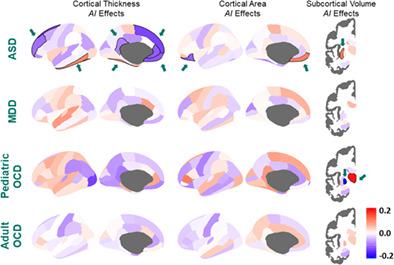当前位置:
X-MOL 学术
›
Hum. Brain Mapp.
›
论文详情
Our official English website, www.x-mol.net, welcomes your feedback! (Note: you will need to create a separate account there.)
Mapping brain asymmetry in health and disease through the ENIGMA consortium
Human Brain Mapping ( IF 4.8 ) Pub Date : 2020-05-18 , DOI: 10.1002/hbm.25033 Xiang-Zhen Kong 1 , Merel C Postema 1 , Tulio Guadalupe 1 , Carolien de Kovel 1 , Premika S W Boedhoe 2, 3 , Martine Hoogman 4, 5 , Samuel R Mathias 6 , Daan van Rooij 5 , Dick Schijven 1 , David C Glahn 6, 7 , Sarah E Medland 8 , Neda Jahanshad 9 , Sophia I Thomopoulos 9 , Jessica A Turner 10, 11 , Jan Buitelaar 5, 12, 13 , Theo G M van Erp 14, 15 , Barbara Franke 16, 17 , Simon E Fisher 1, 18 , Odile A van den Heuvel 2, 3 , Lianne Schmaal 19, 20 , Paul M Thompson 10 , Clyde Francks 1, 18
Human Brain Mapping ( IF 4.8 ) Pub Date : 2020-05-18 , DOI: 10.1002/hbm.25033 Xiang-Zhen Kong 1 , Merel C Postema 1 , Tulio Guadalupe 1 , Carolien de Kovel 1 , Premika S W Boedhoe 2, 3 , Martine Hoogman 4, 5 , Samuel R Mathias 6 , Daan van Rooij 5 , Dick Schijven 1 , David C Glahn 6, 7 , Sarah E Medland 8 , Neda Jahanshad 9 , Sophia I Thomopoulos 9 , Jessica A Turner 10, 11 , Jan Buitelaar 5, 12, 13 , Theo G M van Erp 14, 15 , Barbara Franke 16, 17 , Simon E Fisher 1, 18 , Odile A van den Heuvel 2, 3 , Lianne Schmaal 19, 20 , Paul M Thompson 10 , Clyde Francks 1, 18
Affiliation

|
Left–right asymmetry of the human brain is one of its cardinal features, and also a complex, multivariate trait. Decades of research have suggested that brain asymmetry may be altered in psychiatric disorders. However, findings have been inconsistent and often based on small sample sizes. There are also open questions surrounding which structures are asymmetrical on average in the healthy population, and how variability in brain asymmetry relates to basic biological variables such as age and sex. Over the last 4 years, the ENIGMA-Laterality Working Group has published six studies of gray matter morphological asymmetry based on total sample sizes from roughly 3,500 to 17,000 individuals, which were between one and two orders of magnitude larger than those published in previous decades. A population-level mapping of average asymmetry was achieved, including an intriguing fronto-occipital gradient of cortical thickness asymmetry in healthy brains. ENIGMA's multi-dataset approach also supported an empirical illustration of reproducibility of hemispheric differences across datasets. Effect sizes were estimated for gray matter asymmetry based on large, international, samples in relation to age, sex, handedness, and brain volume, as well as for three psychiatric disorders: autism spectrum disorder was associated with subtly reduced asymmetry of cortical thickness at regions spread widely over the cortex; pediatric obsessive–compulsive disorder was associated with altered subcortical asymmetry; major depressive disorder was not significantly associated with changes of asymmetry. Ongoing studies are examining brain asymmetry in other disorders. Moreover, a groundwork has been laid for possibly identifying shared genetic contributions to brain asymmetry and disorders.
中文翻译:

通过 ENIGMA 联盟绘制健康和疾病中的大脑不对称图
人脑的左右不对称是其基本特征之一,也是一个复杂的、多元的特征。数十年的研究表明,大脑不对称性可能会在精神疾病中发生改变。然而,研究结果并不一致,而且通常基于小样本。关于健康人群中哪些结构平均不对称,以及大脑不对称的变异性与年龄和性别等基本生物变量之间的关系,也存在一些悬而未决的问题。在过去 4 年里,ENIGMA-偏侧性工作组基于大约 3,500 至 17,000 个人的总样本量,发表了六项灰质形态不对称性研究,这些研究比前几十年发表的研究大一到两个数量级。实现了平均不对称性的人群水平绘图,包括健康大脑中有趣的额枕叶皮质厚度不对称梯度。ENIGMA 的多数据集方法还支持对跨数据集的半球差异的再现性进行实证说明。根据与年龄、性别、惯用手和脑容量相关的大型国际样本,以及三种精神疾病,估计了灰质不对称性的效应大小:自闭症谱系障碍与区域皮质厚度不对称性的轻微减少有关广泛分布于皮质;儿童强迫症与皮质下不对称性改变有关;重度抑郁症与不对称性的变化没有显着相关。正在进行的研究正在检查其他疾病中的大脑不对称性。此外,还为可能确定大脑不对称和疾病的共同遗传贡献奠定了基础。
更新日期:2020-05-18
中文翻译:

通过 ENIGMA 联盟绘制健康和疾病中的大脑不对称图
人脑的左右不对称是其基本特征之一,也是一个复杂的、多元的特征。数十年的研究表明,大脑不对称性可能会在精神疾病中发生改变。然而,研究结果并不一致,而且通常基于小样本。关于健康人群中哪些结构平均不对称,以及大脑不对称的变异性与年龄和性别等基本生物变量之间的关系,也存在一些悬而未决的问题。在过去 4 年里,ENIGMA-偏侧性工作组基于大约 3,500 至 17,000 个人的总样本量,发表了六项灰质形态不对称性研究,这些研究比前几十年发表的研究大一到两个数量级。实现了平均不对称性的人群水平绘图,包括健康大脑中有趣的额枕叶皮质厚度不对称梯度。ENIGMA 的多数据集方法还支持对跨数据集的半球差异的再现性进行实证说明。根据与年龄、性别、惯用手和脑容量相关的大型国际样本,以及三种精神疾病,估计了灰质不对称性的效应大小:自闭症谱系障碍与区域皮质厚度不对称性的轻微减少有关广泛分布于皮质;儿童强迫症与皮质下不对称性改变有关;重度抑郁症与不对称性的变化没有显着相关。正在进行的研究正在检查其他疾病中的大脑不对称性。此外,还为可能确定大脑不对称和疾病的共同遗传贡献奠定了基础。



























 京公网安备 11010802027423号
京公网安备 11010802027423号